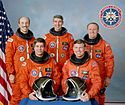STS-29
 | |
| Dane misji | |
| Indeks COSPAR | 1989-021A |
|---|---|
| Zaangażowani | |
| Oznaczenie kodowe | STS-29 |
| Pojazd | |
| Wahadłowiec | |
| Załoga | |
 Od lewej: James P. Bagian, John E. Blaha, Robert C. Springer, Michael L. Coats i James F. (Jim) Buchli. | |
| Start | |
| Miejsce startu | |
| Początek misji | 13 marca 1989, 14:57:00 UTC |
| Orbita okołoziemska | |
| Apogeum | 308 km |
| Perygeum | 297 km |
| Okres orbitalny | 90,6 min |
| Inklinacja orbity | 28,5° |
| Lądowanie | |
| Miejsce lądowania | Edwards AFB, Pas startowy 22 |
| Lądowanie | 18 marca 1989, 14:35:51 |
| Czas trwania misji | 4 dni, 23 godz, 38 min, 52 sek |
| Przebyta odległość | 3 200 000 km |
| Liczba okrążeń Ziemi | 80 |
| Program lotów wahadłowców | |
STS-29 (ang. Space Transportation System) – ósma misja wahadłowca kosmicznego Discovery i dwudziesta ósma programu lotów wahadłowców[1].
Załoga[1]
- Michael Coats (2)*, dowódca
- John Blaha (1), pilot
- James Bagian (1), specjalista misji
- James Buchli (3), specjalista misji
- Robert Springer (1), specjalista misji
- *(liczba w nawiasie oznacza liczbę lotów odbytych przez każdego z astronautów)
Parametry misji
- Masa:
- startowa orbitera: 116 281 kg
- lądującego orbitera: 88 353 kg
- ładunku: 17 280 kg
- Perygeum: 297 km
- Apogeum: 308 km
- Inklinacja: 28,5°
- Okres orbitalny: 90,6 min
Cel misji
Umieszczenie na orbicie satelity telekomunikacyjnego typu TDRS-4[1].
Zobacz też
Przypisy
Linki zewnętrzne
- podsumowanie misji STS-29 na stronie NASA (ang.)
- Mark Wade: STS-29 (ang.). W: Encyclopedia Astronautica [on-line]. [dostęp 2017-07-23].
- Spaceflight mission report: STS-29 (ang.). W: Spacefacts [on-line]. [dostęp 2017-07-23].
Media użyte na tej stronie
The flag of Navassa Island is simply the United States flag. It does not have a "local" flag or "unofficial" flag; it is an uninhabited island. The version with a profile view was based on Flags of the World and as a fictional design has no status warranting a place on any Wiki. It was made up by a random person with no connection to the island, it has never flown on the island, and it has never received any sort of recognition or validation by any authority. The person quoted on that page has no authority to bestow a flag, "unofficial" or otherwise, on the island.
STS-29 Mission Insignia
The STS-29 patch was designed to capture and represent the energy and dynamic nature of this nation's space program as America continues to look to the future. The folded ribbon border, the first of its kind in the Shuttle patch series, gives a sense of three dimensional depth to the emblem. The stylistic orbital maneuvering system (ONS) burn symbolizes the powerful forward momentum of the Shuttle and a continuing determination to explore the frontiers of space. The colors of the U.S. flag are represented in the patch's basic red, white, and blue background. In the border, the seven stars between the STS-29 crew names are a tribute to the crew of Challenger.
Five astronauts composed the STS-29 crew. Standing (left ot right) are James P. Bagian, mission specialist 1; Robert C. Springer, mission specialist 3; and James F. (Jim) Buchli, mission specialist 2. Seated (left to right) are John E. Blaha, pilot, and Michael L. Coats, commander. STS-29 launched aboard the Space Shuttle Discovery on March 13, 1989 at 9:57 am (EST). The primary payload was the Tracking and Data Relay Satellite- 4 (TDRS-4).


